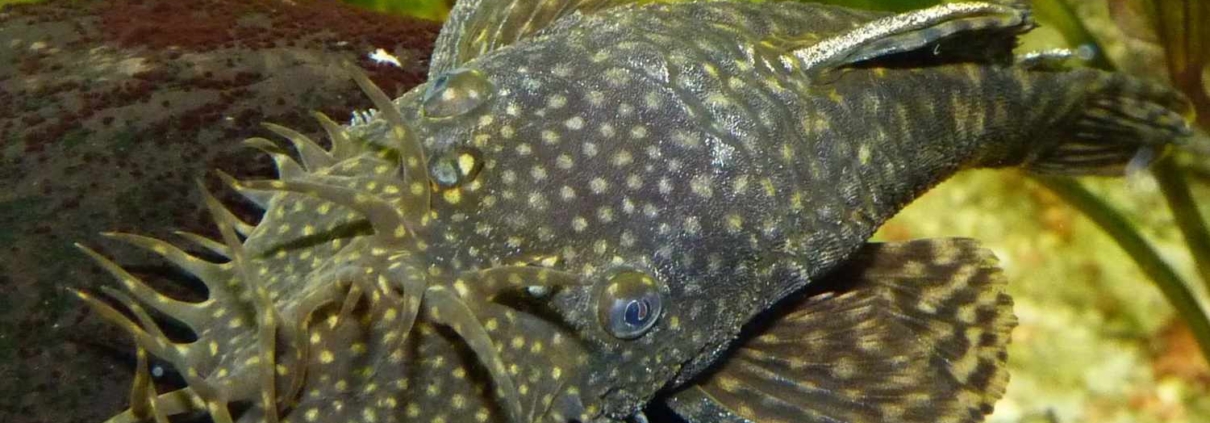Bristlenose Plecos care guide
Bristlenose Plecos, also known as Bristlenose Catfish or Bushy Nose Plecos, are a popular choice for aquarium hobbyists due to their small size, peaceful nature, and ability to help maintain clean tanks. These bottom-dwelling fish are native to South America and are known for their distinctive bristly tentacles on their snout, which are used for feeding and territorial display.
Contents
Facts about Bristlenose Plecos:
- Bristlenose Plecos can reach a maximum size of around 6 inches in length.
- They are nocturnal, meaning they are most active at night.
- Bristlenose Plecos are omnivorous, meaning they will eat both plant matter and small invertebrates.
- They are generally peaceful fish and do well in community tanks with other peaceful species.
- Bristlenose Plecos are popular among aquarists due to their ability to help maintain clean tanks by eating algae and leftover food.
Appearance of Bristlenose Plecos
Bristlenose Plecos have a distinctive appearance, with a brown or greenish coloration and a pattern of dark spots on their body. They have a protruding snout with bristly tentacles, which are used for feeding and territorial display. Males tend to have longer and thicker tentacles than females. Bristlenose Plecos have a smooth, scaleless body and a small, downturned mouth with small, sharp teeth.
Types of Bristlenose Plecos
There are several recognized types of Bristlenose Plecos, including the Common Bristlenose Pleco, the Albino Bristlenose Pleco, and the Longfin Bristlenose Pleco. The Common Bristlenose Pleco is the most commonly available type, and is characterized by a brown or greenish coloration and a pattern of dark spots on their body. The Albino Bristlenose Pleco is a popular variation that has a pale pink or white coloration with red eyes. The Longfin Bristlenose Pleco is a rarer type that has elongated fins and a more streamlined body shape.
Sexing and Pregnancy
Males and females can be distinguished by the size and shape of their tentacles. Males tend to have longer and thicker tentacles, while females have shorter and finer tentacles. During pregnancy, female Bristlenose Plecos will develop a swollen belly and may become more reclusive. Bristlenose Plecos are livebearers, meaning they give birth to live offspring rather than laying eggs. Female Bristlenose Plecos can carry up to 60 eggs at a time, which will hatch within 3-4 weeks.
Preferred Habitat
Bristlenose Plecos are native to South America and are found in slow-moving rivers and streams. In the aquarium, they prefer a moderate current and a substrate of fine gravel or sand. They prefer a well-planted tank with plenty of hiding places, such as caves or overhangs.
Bristlenose Plecos are relatively easy to care for and can thrive in a well-maintained aquarium. It is important to provide them with a suitable habitat that replicates their natural environment, including a consistent water temperature, pH, and hardness range. They prefer a water temperature of 72-82 degrees Fahrenheit and a pH range of 6.0-7.5. It is also important to provide them with a varied and nutritious diet, including high-quality pellet or flake food as well as live or frozen foods such as brine shrimp, daphnia, or bloodworms. Bristlenose Plecos are omnivorous and will benefit from a diet that includes both plant matter and small invertebrates.
In addition to their diet, it is important to provide Bristlenose Plecos with plenty of space and hiding places in the tank. They are bottom-dwelling fish and prefer a substrate of fine gravel or sand to burrow and hide in. They also appreciate plenty of plants and other decorations to provide additional hiding places and places to rest. It is important to provide enough space and hiding places to prevent overcrowding and potential aggression. Bristlenose Plecos are generally peaceful fish and do well in community tanks with other peaceful species.
Bristlenose Plecos are known for their ability to help maintain clean tanks by eating algae and leftover food. However, it is important to provide regular maintenance and clean the tank to ensure that the water remains clean and healthy for your fish. This includes regularly changing the water and cleaning the substrate, as well as maintaining the filter and other equipment. By providing a clean and well-maintained habitat, you can help to ensure the well-being and longevity of your Bristlenose Plecos.
Common Questions and Answers
Q: Can Bristlenose Plecos be kept with other fish species?
A: Bristlenose Plecos are generally peaceful and can be kept with other peaceful fish species. It is important to research the compatibility of any new fish before adding them to the tank to ensure that they are compatible with your Bristlenose Plecos and will not cause aggression or harm.
Q: Do Bristlenose Plecos need a filter?
A: Yes, Bristlenose Plecos do need a filter to maintain good water quality and remove excess waste and toxins from the tank. It is important to choose a high-quality filter that is suitable for the size of your tank and the number of fish you are keeping. A well-maintained filter will help to keep the water clean and healthy for your Bristlenose Plecos, as well as help to oxygenate the water and maintain a consistent temperature and pH range.
Q: Can Bristlenose Plecos be kept in a small tank?
A: Bristlenose Plecos can be kept in a small tank, but it is important to provide enough space and hiding places to prevent overcrowding and potential aggression. It is recommended to provide at least 20 gallons of space per Bristlenose Pleco.
Q: Do Bristlenose Plecos eat live plants?
A: Bristlenose Plecos are generally not known to eat live plants, but they may nibble on softer-leaved plants or plants that are not well-established. It is important to research the compatibility of any plants with your Bristlenose Plecos before adding them to the tank to ensure that they will not cause harm.


